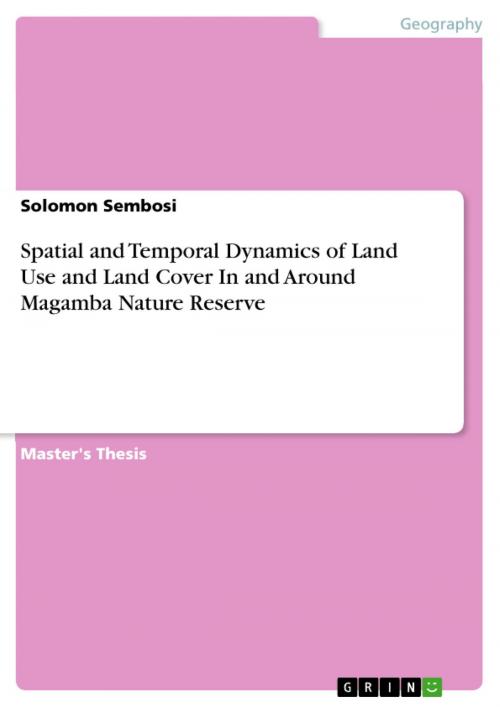Spatial and Temporal Dynamics of Land Use and Land Cover In and Around Magamba Nature Reserve
Nonfiction, Social & Cultural Studies, Social Science, Human Geography| Author: | Solomon Sembosi | ISBN: | 9783668568808 |
| Publisher: | GRIN Verlag | Publication: | November 13, 2017 |
| Imprint: | GRIN Verlag | Language: | English |
| Author: | Solomon Sembosi |
| ISBN: | 9783668568808 |
| Publisher: | GRIN Verlag |
| Publication: | November 13, 2017 |
| Imprint: | GRIN Verlag |
| Language: | English |
Master's Thesis from the year 2017 in the subject Geography / Earth Science - Regional Geography, , course: Ecosystems Science and Management, language: English, abstract: This study assesses land use and land cover changes and the causes of such changes in and around Magamba Nature Reserve. Remote sensing and GIS techniques were used to quantify and analyze the trend in land use and land cover changes over the past 20 years whereby satellite images of 1995, 2008 and 2015 were used. Moreover, household surveys, direct field observations and focus group discussions were employed to obtain socioeconomic factors that influence changes in land use and land cover. Population Census data of 2002 and 2012 were utilized to identify population density for the villages surrounding the reserve. The results indicated a major expansion of agriculture from 169.33 ha in 1995, 282.16 ha in 2008 to 902.54 ha in 2015. There was an increase of built-up areas from 36.50 ha in 1995, 911.56 ha in 2008 to 1792.92 ha in 2015 at the expense of other land covers. The identified influences for such changes include population pressure, unemployment, landless, agricultural expansion, fire and need for energy sources (e.g. firewood and charcoal). Recent increase in population and anthropogenic activities is a threat to conservation and thus should be discouraged in order to restore the degraded areas and for the sustainability of the biodiversity in and around Magamba Nature Reserve. Magamba Nature Reserve in Lushoto District Tanzania has experienced and continues to experience major land use changes and land cover loss in natural vegetation. This has resulted in biodiversity loss, local climate change, soil erosion and forest degradation. Therefore, understanding of changes occurring in such ecosystem is of vital importance for establishing management activities. It has been lately indicated that these problems are mainly due to anthropogenic activities as this district is among the rural areas with high population growth compared to other rural districts in Tanzania. However, these insights are little proved quantitatively.
Master's Thesis from the year 2017 in the subject Geography / Earth Science - Regional Geography, , course: Ecosystems Science and Management, language: English, abstract: This study assesses land use and land cover changes and the causes of such changes in and around Magamba Nature Reserve. Remote sensing and GIS techniques were used to quantify and analyze the trend in land use and land cover changes over the past 20 years whereby satellite images of 1995, 2008 and 2015 were used. Moreover, household surveys, direct field observations and focus group discussions were employed to obtain socioeconomic factors that influence changes in land use and land cover. Population Census data of 2002 and 2012 were utilized to identify population density for the villages surrounding the reserve. The results indicated a major expansion of agriculture from 169.33 ha in 1995, 282.16 ha in 2008 to 902.54 ha in 2015. There was an increase of built-up areas from 36.50 ha in 1995, 911.56 ha in 2008 to 1792.92 ha in 2015 at the expense of other land covers. The identified influences for such changes include population pressure, unemployment, landless, agricultural expansion, fire and need for energy sources (e.g. firewood and charcoal). Recent increase in population and anthropogenic activities is a threat to conservation and thus should be discouraged in order to restore the degraded areas and for the sustainability of the biodiversity in and around Magamba Nature Reserve. Magamba Nature Reserve in Lushoto District Tanzania has experienced and continues to experience major land use changes and land cover loss in natural vegetation. This has resulted in biodiversity loss, local climate change, soil erosion and forest degradation. Therefore, understanding of changes occurring in such ecosystem is of vital importance for establishing management activities. It has been lately indicated that these problems are mainly due to anthropogenic activities as this district is among the rural areas with high population growth compared to other rural districts in Tanzania. However, these insights are little proved quantitatively.















